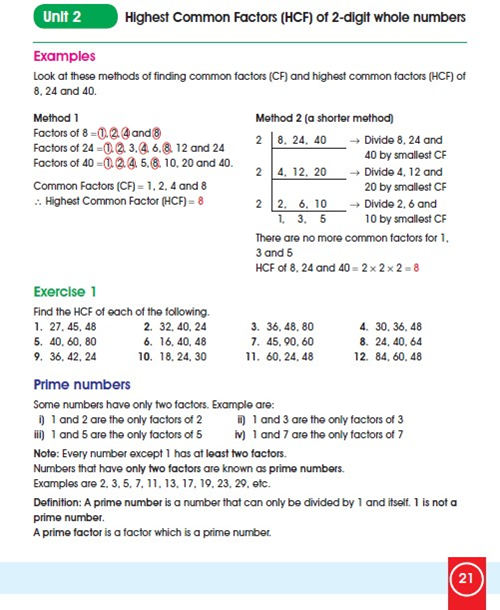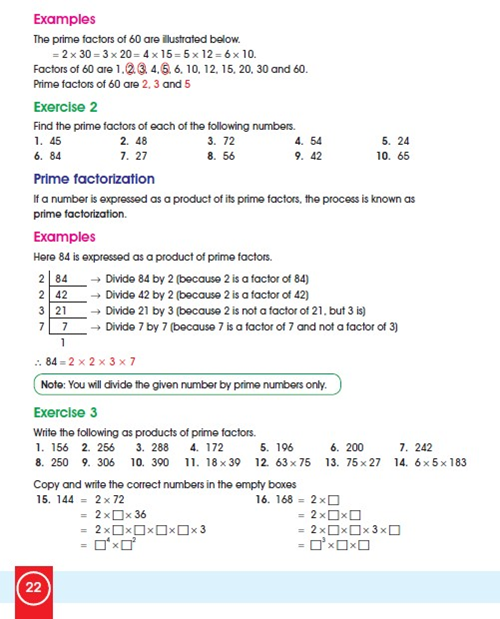Lesson Notes By Weeks and Term - Primary 6
HCF and LCM
WEEK 4
SUBJECT: MATHEMATICS
TERM: 1ST TERM
CLASS PRIMARY 6
TOPIC: HCF and LCM
Find common factors of 2-digit whole numbers
Find the HCF of 2-digit whole numbers
Find common multiples of 2-digit whole numbers find the LCM of 2-digit whole numbers.
Common factors of 2-digit whole numbers
A factor of a given number is a number that can divide the given number without a remainder. For instance 2 can divide 6 without a remainder, hence 2 is a factor of 6.
Rules for divisibility
2: A number is divisible by 2 if the last digit is an even number or zero.
3: A number is divisible by 3 if the sum of the digits is divisible by 3. For example, 4 302.
4 + 3 + 0 + 2 = 9, this is divisible by 3. Hence 4 302 is divisible by 3. Therefore, 3 is a factor of 4 302.
4: A number is divisible by 4, if the last two digits are zeros or if the last two digits of the number is divisible by 4. Examples
75 is divisible by 5 Hence 5 is a factor of 75
80 is divisible by 5 5 is a factor of 80
76 is not divisible by 5. 5 is not a factor of 76.
78 is divisible by 2 76 is divisible by 2
78 is also divisible by 3 but 76 is not divisible by 3.
Hence 78 is divisible by 6. (Remember 7 + 6 = 13 and 13 is not divisible by 3) ! 6 is a factor of 78. Since 2 but not 3 can divide 76 without remainder.
Thus 76 is not divisible by 6.
! 6 is not a factor of 76.
7: A number is divisible by 7 if the difference between twice the last digit and the number formed by the remaining digits is divisible by 7.
The last digit is 1. The last digit is 9.
Twice the last digit is 2 × 1 = 2. Twice the last digit is 2 × 9 = 18.
The remaining digit is 9. The remaining digits = 95.
Difference between 9 and 2 is 7. Difference between 95 and 18 = 95 – 18 = 77 Since 7 is divisible 7. Since 77 is divisible by 7.
91 is also divisible by 7. 959 is also divisible by 7.
Thus 7 is a factor of 91. Thus 7 is a factor of 959.
8: A number is divisible by 8 if the last three digits are zeros or the number is divisible by 2 without a remainder three times.
784 ÷ 2 = 392 (First division) 748 ÷ 2 = 374 (First division)
392 ÷ 2 = 196 (Second division) 374 ÷ 2 = 187 (Second division)
196 ÷ 2 = 98 (Third division) 187 ÷ 2 = 93 remainder 1 (Third division) Thus 784 ÷ 8 = 98 Here 748 cannot be divided by 2, without a remainder, three times.
Thus 8 cannot divide 748 without a remainder.
Hence 8 is factor of 784. Therefore 8 is not a factor of 748.
20
9: A number is divisible by 9, if the sum of its digits is divisible by 9.
8 + 0 + 1 = 9 2 + 3 + 4 = 9
Since 9 is divisible by 9 Since 9 is divisible by 9 Then 801 is divisible by 9 Then 234 is divisible by 9 Hence 9 is a factor of 801. Hence 9 is a factor of 234.
10: A number is divisible by 10 if the last digit is ZERO. For example, 180 is divisible by 10 but 108 is not. Thus 10 is a factor of 180, but not a factor of 108.
How to find the factors of a given number
Starting from 1, find all other numbers that can divide the given number without a remainder. Examples
This method finds the factors of 48.
48 = 1 × 48
= 2 × 24
= 3 × 16
= 4 × 12
= 6 × 8
For each number, list all the factors.
Common factors
Look at the method of finding the common factors of 24 and 30.
Factors of 24 are 1, 2, 3, 4, 6, 8, 12 and 24 Factors of 30 are 1, 2, 3, 5, 6, 10, 15 and 30
Common factors of 24 and 30 are 1, 2, 3, and 6
Find the common factors of the following numbers.
Highest Common Factors (HCF) of 2-digit whole numbers


Finding HCF using prime factorisation
Find the Highest Common Factor (HCF) of 18 and 30.
Solution
Note: The common prime factors are 2 and 3.
! Highest Common Factors (HCF) = 2 × 3 = 6
6 is the highest factor that can divide both 18 and 30.
The other number has 5 as one of its factors. What is the other number?
Unit 3 Common multiples of 2-digit whole numbers
Multiples of a given number are numbers that are formed by successfully multiplying the
given number by counting numbers 1, 2, 3, 4, 5, 6 … Examples
Multiples of 3 and 5 are found here.
Multiples of 3 are 3 × 1 = 3, 3 × 2 = 6, 3 × 3 = 9, 3 × 4 = 12 …
Multiples of 3 are 3, 6, 9, 12…
Multiples of 5 are 5, 10, 15, 20…
Note: Multiples of a number do not end, so we use the sign (…) to show that there are still more.
24
Common multiple: If two or more numbers have the same multiple, such a multiple is known as common multiple to the given numbers.
The common multiples of 2 and 3 are shown below.
Solution
Multiples of 2 are 2, 4, 6 , 8, 10, 12 , 14, 16, 18 , 20, 22, 24 …
Multiples of 3 are 3, 6 , 9, 12 , 15, 18 , 21, 24 , 27, 30, 33, 36,…
Common multiples are 6, 12, 18, 24…
Note: the common multiples are also multiples of 6.
Find the common multiples of these numbers.
Least common multiples
Least common multiple (LCM) of two or more numbers is the least/smallest of all the common multiples of the two or more given numbers.
Least common multiple (LCM) is also known as Lowest Common Multiple.
25
Method 1 (common multiples)
The multiples of 10 are: 10, 20, 30, 40, 50, and 60
The multiples of 15 are: 15, 30, 45, 60, 75, and 90
The multiples of 30 are: 30, 60, 90, 120, 150, and 180 The common multiples of 10, 15 and 30 are 30 and 60 ! The LCM of 10, 15 and 30 is 30.
Solution
Multiples of 9 are 9, 18, 27, 36, 45, 54, 63, 72, 81, 90, 99, 108 …
Multiples of 12 are 12, 24, 36, 48, 60, 72, 84, 96, 108, 120…
Common multiples of 9 and 12 are 36, 72, 108…
Least Common Multiple is the smallest/least of the three common multiples.
! LCM = 36
Find the common multiples and LCM of these numbers.
Here the LCM of 9 and 12 is found using other methods.

© Lesson Notes All Rights Reserved 2023